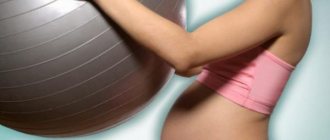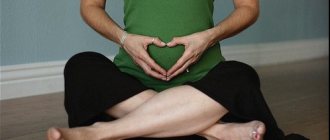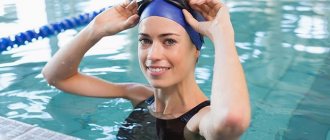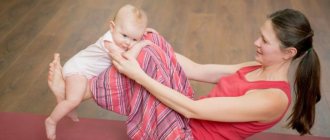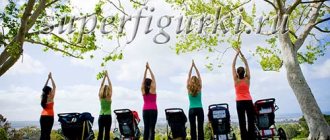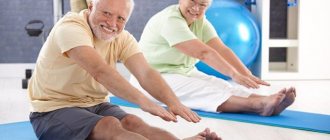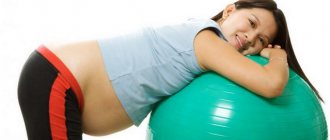Is it possible to go swimming in the second and third trimester of pregnancy?
Pregnancy is not a contraindication to visiting the pool and exercising in water . On the contrary, with a competent approach and compliance with important instructions, swimming will bring a lot of positive emotions and will have a beneficial effect on the health of the expectant mother and the formation of the fetus.
Before signing up for swimming, you must consult with a gynecologist who is managing your pregnancy.
The second trimester (from 13 to 26 obstetric weeks) is considered the safest for physical activity. The fetus is already securely attached to the uterus, the formation of internal organs and systems has occurred, and the formation of the placenta has begun. At this stage, swimming cannot harm the baby, provided it is done in moderation.
The third trimester (from 27 to 40-41 obstetric weeks inclusive) is not as safe as the second. Swimming should be done with caution starting at 36 weeks. At this time, the stomach acquires an impressive size and can cause discomfort during physical activity.
After 36 weeks, the mucus plug may begin to come off , blocking the cervical canal and protecting the internal genital organs from infections. Therefore, a swimming pool can become a risk factor for infectious infection and a negative impact on the health of the fetus.
A LITTLE ABOUT PREGNANCY
Pregnancy is a time when you should think about your physical fitness, even if you haven’t thought about it before. This is the time when the body works for two and it is very good when it works without failures. This is a period of restrictions for some, and opportunities for others, as was said in my other article.
Pregnancy lasts an average of 40 weeks and is divided into three periods, during which there are different recommendations, and sometimes restrictions from specialists.
For example, the first trimester (from 1 to 12 weeks) is the most dangerous for a fetus that is still small and not fully established in the female body. And here any physical activity must be very careful, as it can lead to miscarriage.
But, starting from weeks 13-16, it’s time to take care of your physical body. And the most useful thing that can be is swimming, or physical exercise in the water.
Water is the source of all life on earth and is the most powerful source of energy. From the very moment of conception, the little man swims in the amniotic fluid, and this environment is natural for him.
A pregnant woman who is gradually gaining weight can miraculously feel light and mobile again only in water, which supports the spine and strengthens the muscles. But as in any business, of course, there are also recommendations here.
There are many exercises and techniques specifically designed for pregnant women, taking into account their physical condition. Similar techniques are used in special courses to prepare for childbirth. The courses have their own schedule and location, which may not always suit a pregnant woman. And in the nearby pool such courses may not be taught. And then a woman can independently study the simple exercises described in this article and apply them when visiting the pool at a time convenient for herself.
What are the basic exercises that pregnant women should do in the pool for benefit and pleasure? They have been tested in my personal experience and brought me quite tangible benefits both during pregnancy itself and during childbirth (a whole article was written about this exciting event in my life - Frankly about our first birth) and during the postpartum recovery period.
Lack of excess weight (I gained less than 10 kg during pregnancy), elastic skin without stretch marks, good blood circulation and a minimum of problems with the spine - this is already enough to take my slightly heavier body and take it to the pool 
All exercises can be divided into groups.
What are the benefits of this sport in the later stages?
If a woman, after consultation with a doctor, has received approval to exercise in water, she can visit either specialized institutions or the aqua zone in a sports club.
Health benefits for pregnant women:
- During training, the load on different muscle groups alternates, the muscle corset is strengthened, and overall endurance increases.
- Relaxation and gentle tightening of muscles serve to prevent varicose veins and hemorrhoids, and reduces the risk of postpartum stretch marks.
- Intestinal function improves by enhancing its motility.
- Swimming reduces the load on the spine and helps relieve pain in the lower back and shoulder girdle.
- The functioning of the cardiovascular and respiratory systems is optimized, lung volume increases, which has a positive effect on the course of childbirth.
- The processes of thermoregulation and adaptation to the external environment are improved, and the immune system is strengthened.
Benefits for pregnancy and fetus:
- Intense breathing promotes the entry of large amounts of oxygen into the lungs and improves blood supply to the fetus.
- Immersion classes allow the baby to adapt to the lack of oxygen that may occur during childbirth.
- With breech placenta previa, special exercises in the pool will help the baby take the correct position in the uterus.
Group classes for pregnant women in the pool
Exercising with a group of other pregnant women under the supervision of an experienced trainer is much more fun, safer and more beneficial than exercising alone. Group training offers some pretty original exercises.
- "Star". Pregnant women stand in a circle and hold hands. They lie face down on the water on command and hold their breath. This is one of the first training sessions for a child.
- "Birth of a child". All the practicing women stand one after the other, forming a tunnel from their widely spaced legs, into which the last woman must dive, as if into the birth canal. In this case, you need to try to bend like a child being born and not help yourself with your hands.
- "Stretching". Pregnant women break into pairs and stretch each other. One woman holds on to the handrail and lies down on the water, the second pulls her legs. You can also do the “shaking the mat” or “swinging in the hammock” exercise.
Can it cause harm?
Swimming in a pool cannot be considered an absolutely safe procedure. In some cases, sessions can harm a woman and her child.
Harm to the health of a pregnant woman:
- Incorrect swimming technique can lead to deterioration in well-being after the session.
- Chlorine, which is used to disinfect water, often causes allergic reactions. It is preferable for expectant mothers to visit swimming pools where the water is purified not with chlorine, but with ultraviolet light, ozone or ultrasound.
- In swimming pools where proper attention is not paid to hygiene issues, there is a chance of contracting an infectious disease or fungus.
- Swimming in cold water (below 22°C) often provokes cramps of the lower extremities and can lead to colds and inflammation of the lower urinary tract.
Harm to pregnancy and fetus:
- Intense physical activity in water can cause increased uterine tone, the threat of spontaneous abortion and premature birth.
- Holding your breath for a long time in water leads to excessive oxygen starvation of the embryo.
- Swimming after the mucus plug has come out is fraught with infection of the internal genital organs and fetal organs.
Contraindications
There are a number of contraindications to swimming sessions . If you have these indications, you will have to refuse to visit the pool and bodies of water:
- any risk factors for miscarriage and premature birth;
- placenta previa, including with the risk of bleeding;
- sexual infections;
- bloody discharge from the genitals;
- pain in the lower abdomen;
- feeling unwell – headaches, dizziness, shortness of breath;
- severe toxicosis;
- epilepsy, gestosis;
- all types of infectious diseases and chronic pathologies in the acute stage.
Women who have had recurrent miscarriages in previous pregnancies should not swim.
Restrictions during classes
In order for swimming and activities in water to bring only benefits, it is necessary:
- do not get too cold in the pool;
- stop exercising if any discomfort occurs;
- do not exercise in water temperatures below 28 °C;
- one water session should not last more than 40 minutes;
- It is prohibited to jump from the stand and sides into the water;
- you cannot “hang” on the floats of the delimiters;
- you cannot swim to great depths if you have insufficient swimming skills;
- avoid sudden temperature changes;
- do not make sudden movements in the water and intensively increase the pace of training;
- do not exercise on an empty or full stomach;
- It is prohibited to wear shoes with slippery soles in the pool.
Video: Dancing and free movements in the water
Water aerobics classes for pregnant women are always carried out under the supervision of a trainer and nurse .
If you feel uncomfortable (dizzy, cold, increased heart rate), you should stop the activity!
When choosing a pool where your classes will take place, ask how the water is purified (cleaning should be done without the use of chlorine). And also watch a video of water aerobics classes for pregnant women on the website of the selected institution.
Don’t forget that to attend water aerobics classes for pregnant women, you need to have certificates from your therapist and gynecologist stating that you have no contraindications to exercise in the pool.
Exercises
Ideally, classes with pregnant women should be conducted by a qualified instructor who has certain knowledge and skills in working with expectant mothers. But you can practice on your own if you know the recommended complex and rules for performing each exercise. It is better to start the session with a warm-up - slowly walk along the bottom of the pool, stretching your arms forward and pushing off the surface of the water with your palms.
Three formats of training are recommended for pregnant women: water aerobics, swimming and diving.
Description of exercises:
- Stand in front of the side, grab it with your hands. Squat down, resting your feet against the wall, and then push off, straightening your torso.
- Perform the bicycle exercise by holding the side. You can simply rotate or lift your legs in different directions.
- Lie on your stomach, grab the side and pull your legs towards your stomach.
- Lie on your back, stretch your legs forward, spread your limbs to the sides, and then bring them together again.
- Take a supine position with your legs extended. Bend your legs at the knees and pull them towards your stomach, then straighten them again.
- Place one leg to the side, squatting on the other and trying to achieve maximum stretching. Then the second leg is stretched.
The number of approaches of the exercises described above is 3-4 times.
- Turn to face the board and grab the support with both hands. Place a rubber ball between your legs and squeeze it 10-20 times, alternately tensing and relaxing the muscles.
- Grasp the ball with your hands and make revolutions around its axis - 8-10 turns per session.
- Lie on your back with your arms along your torso. Swim for a few seconds, working with your legs and torso.
- Take a deep breath and squat underwater, clasping your knees with your hands. Hold your breath until the water itself pushes to the surface.
- Make a deep entry and position yourself on the water in the “star” position, face down. After a few seconds, stand up and take a leisurely breath.
The duration of the first swimming session should not exceed 20 minutes. Then classes are gradually increased to 40 minutes.
The training ends with relaxation exercises. To do this, just put an inflatable pillow under your head and lie on your back. In this position, you can make light movements with your arms and legs, and then relax as much as possible.
If your pregnancy is progressing well and there are no contraindications to light physical activity, you can swim for fun. Don't forget to consult your gynecologist .
EXERCISES TO STRENGTHEN THE MAIN MUSCLE GROUPS OF THE LEGS AND BUTTOCKS
The following exercises are aimed at strengthening the main muscle groups of the legs and buttocks and are performed at the side:
- Stand with your back to the side. Swing your leg in front of you at the surface of the water.
- Stand with your back to the side. The leg is straightened in front of you. Toe of the foot towards you, away from you.
- Stand with your back to the side. The leg is straightened in front of you. We twist the leg at the hip joint inward and outward.
- Exercises 1-3 with the other leg.
- Standing with your left side to the side. Straighten your right leg to the side. Straight leg circles forward, backward.
- Standing with your left side to the side. Bend your right leg at the knee and grab it with your right hand by the knee. Use your hand to return the knee forward - down and back. "Chicken wing."
- Standing with your left side to the side. Bend your right leg at the knee and grab it with your right hand by the knee. Twist your knee with your hand so that the right hip joint works. Back and forth.
- Standing with your left side to the side. Bend your right leg at the knee and grab it with your right hand by the knee. Return to the side to the left with your whole body standing on a stationary leg, then turn around back. Without releasing your knee, bend your body to the right, trying to place your right ear on your right knee.
- Standing with your left side to the side. Bend your right leg at the knee and grab it with your right hand by the knee. Stand for a few seconds, trying to keep your body straight and “opening” yourself with your hand behind your knee while exhaling long.
- Exercises 5-9 with the other leg.
- Stand facing the side. Swing your right leg straight back without lowering your leg to the bottom.
- Straighten your right leg back, then bend your leg at the knee and swing your heel with elastic movements, trying to press it to your buttock.
- Remaining in the same position, grab your right toe with your right hand and pull your bent leg up.
- Exercises 11-13 with the other leg.
